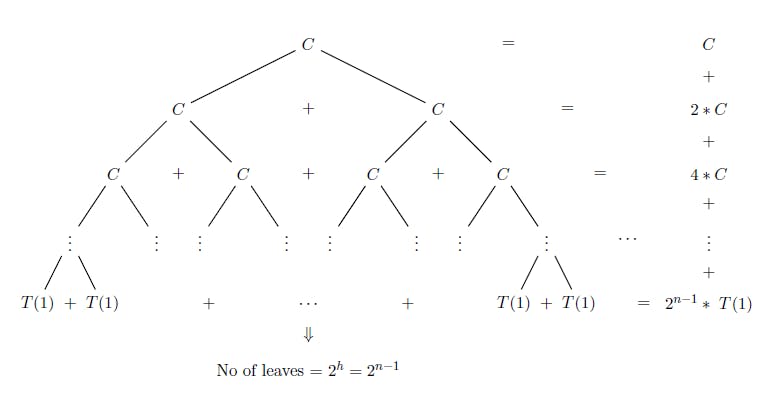Method to determine complexity from the Recursion Tree
Let us take an example recursion tree, C being the function called recursively, T(1) as base case.

Code interpretation can look like this,
function C(param) {
if(param == some condition) //Base Case // Leaf
return 1 // T(1)
//do something
C(paramNew1) //next computation // branch 1 to the recursion tree
C(paramNew2) //next computation // branch 2 to the recursion tree
....
}
- Notice two things:
- tree depth is the total number of return statements executed until we reach base case , along the most distant node from the root of the tree.
- In above diagram it is n-1.
- tree breadth is total number recursive function calls that are made at a given time.
- In above diagram it is 2. A function , at a given time, it is getting split into two more functions.
- tree depth is the total number of return statements executed until we reach base case , along the most distant node from the root of the tree.
Time Complexity Analysis
- Draw the recursion tree
- For arbitrary
n, find out the depthdof the tree asf(n) - Find out average branching factor
bi.e. how many children are present per node on average - If we want to visit every node in a tree of depth
dwith branching factorb, we take at least bd operations. - ~ O(bd)
Space Complexity Analysis
- Memory complexity is determined by the number of recursion calls ( which are stored on program stack )
- ~ O(recursion depth)
Example - Edit Distance
Let us take example from the previous post
Code
public int minDistance(String word1, String word2) {
return ED(word1,word2,0,0);
}
private int ED(String s1, String s2, int i, int j){
if(i==s1.length())
return s2.length()-j; // remaining size difference
if(j==s2.length())
return s1.length()-i; // remaining size difference
if(s1.charAt(i) == s2.charAt(j))
return ED(s1,s2,i+1,j+1); //cost = 0
else
return Math.min(Math.min(
ED(s1,s2,i,j+1), //insertion
ED(s1,s2,i+1,j)), //deletion
ED(s1,s2,i+1,j+1)) //substitution
+ 1; //cost = 1 for Levenshtein
}
Complexity Analysis
Using Method to determine complexity from the Recursion Tree , let's say,
s1is the first string ands2is the second string- s1 is of
mlength and s2 is ofnlength - So, Depth
dof the tree will bemin(m,n).- As, we terminate early when we have finished iterate over the smaller string.
- And, Branching factor
bwill be3.- As we call the function
EDrecursively, for insertion, deletion and substitution.
- As we call the function
Time complexity:
- O(3 min(m,n)) , at the least
- O(3n) , at worst case and it occurs when m=n
Space complexity:
- O(n) at the worst case
Questions
The time complexity is exponential in nature. In what test case will it be inefficient for Edit Distance? Why?
hint!
"dinitrophenylhydrazine"
"acetylphenylhydrazine"
Try to draw the recursion tree for this example and find out when does this become inefficient.
Stay tune for the solution in the next blog and understand why it is inefficient. Also, we will explore next approaches to make the Edit Distance algorithm efficient.
Below is a Map of things we have written so far. Also, we would like to hang with people who are doing these algorithms. Join us at Discord or follow us over Twitter/Instagram.

